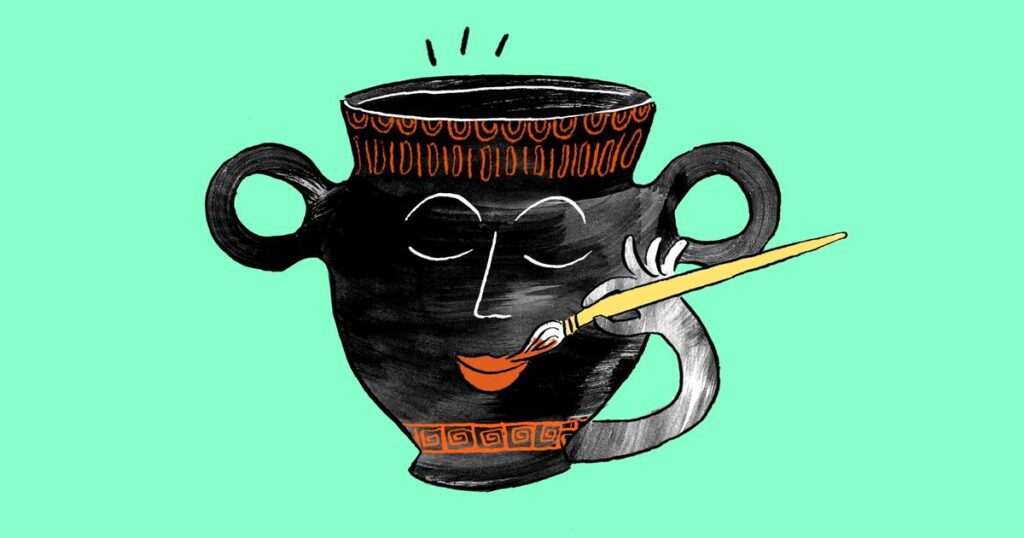The overlooked Etruscans
Before we go into that, let’s have a quick recap of who the Etruscans were. They are the people who lived in parts of what is now Italy, particularly in Tuscany and Umbria, in the period before the rise of ancient Rome, in the first millennium BC. They were neighbours and rivals of the Romans and the Greeks. They lived in cities spread across the region, and from their ports they traded widely across the Mediterranean.
The Etruscans pop up in ancient sources quite often, but we only ever have accounts of them from an outside perspective, because their own texts do not survive beyond short inscriptions and one religious text. We have to rely on those accounts, along with archaeology, to get to grips with who they were and how they lived. Most of their cities are hard to excavate as they sit under modern settlements, but new excavations are revealing more of their world.
Etruscan tombs also provide a fascinating insight into Etruscan culture, and some feature remarkable wall paintings. These paintings show scenes from everyday life, religion and myth, but also some graphic sexual acts, which has surprised modern eyes (I’ll come back to that). Though Etruria was eventually subsumed into the Roman empire in the fourth and third centuries BC, echoes of their culture persisted.
Wall paintings in Etruscan tombs show scenes from everyday life, religion and myth, but also some graphic sexual acts, which has surprised modern eyes
According to Shipley, there is something about the ancient Etruscans that speaks of a people who weren’t afraid to make mistakes, nor who were intimidated by the people around them. They painted their own pots in an inimitable style, and that is something we can draw on today.
Painters, potters and perfectionism
Aside from the wall paintings, in Etruscan tombs archaeologists have found great quantities of red- and black-figure pottery (when the background is black and the details are left in the colour of the clay). This is the sort of material you’ll be familiar with if you’ve ever looked at ancient Greek vases in a museum. It was originally made in Greece, but inspired Etruscan potters to make their own versions.
Some of it was good, but some of it was, well, I’ll leave it to Shipley’s assessment: “They are churning these things out. There is a market for these things, but some of them are terrible. I try not to have value judgments about artefacts, but some of this material looks like somebody has made it with an atrocious red-wine hangover.”
There is one particular example that Shipley highlights, of a red-figure vase with a depiction of a hippocamp, or sea beast, which you would have to be very generous to describe as well-executed.
“I love Etruscan archaeology. I’m really passionate about it, but even I am almost laughing at some of this Etruscan red-figure material. Yet it seems they were perfectly happy with it. It’s just that way of being able to express yourself. Do what you’re going to do – you paint that bad dragon.
“Sometimes the human forms are a bit blobby. They’re not as neat and precise as the ones that you see imported from Greece, but that’s okay. Someone was very happy with that, and I think that’s a really important lesson. I’m a bit of a perfectionist. But sometimes it’s time to tell your internal critic to shut up and accept that actually what you’ve done is totally fine.”
WATCH | Dr Lucy Shipley on letting go of perfectionism
Everyone’s an artist
That’s a good sentiment, but can we really read that broader sense of a cultural carefree spirit among the Etruscans from some sub-par pottery? According to Shipley, there’s ample evidence of this mindset when you look for it. She recalls an archaeological site that she worked at just outside Siena. “Back when Poggio Civitate was a flourishing Etruscan site, this was home to one of the largest buildings of the ancient world, and it was a craft centre. It burnt down in an accidental fire. You can see that people just literally dropped what they were working on and got out before the flames came.
“The result is that you have incredible preservation of the material they were working on. Some of it’s really beautiful, high-quality carving, and terracotta tiles and all sorts of other things. And some of it is really not so much. There’s a whole spectrum of what people were working on, all these different individuals working together in this place.
“Everybody’s doing their best and that’s enough. After that fire, they rebuild in an adjacent area. They build this incredible complex, which has terracotta statues on the roof. If you are looking at, say, the Parthenon marbles, you are going to think that these architectural terracottas are a little bit rustic. They’re quite big and chunky and they don’t have that ‘classical refinement’. But they’re so alive and they’re really enchanting – the famous one is a cowboy figure with a huge hat, and he’s seated on a throne on the roof.”
Standing out from the crowd
Shipley sees similar confidence in Etruscan tomb painting, which some early art historians have described as quite coarse, but which she sees as being alive and full of natural detail. From all this, we can perhaps take the ‘paint your pot’ idea a little further and infer that these people in ancient Etruria were not only content to produce work on their own terms and to their own standards, but also happy to stand out from the crowd, be a little different, and not be worried about unfavourable comparisons with other people, or indeed other cultures. Shipley adds that while Etruscan depictions of Greek myths are often described as being wrong, they’re not – they’re just an Etruscan version and absolutely right to the person telling that story.
“I’m going to stick my neck out here,” says Shipley, “and this could be my bias because I’m enchanted by the Etruscans, but I think if we look at their actions, we can see that these are confident, capable people who are absolutely viewing themselves as equal with the Greek people that they’re trading with and other trading partners.”
So, in Shipley’s assessment, the Etruscans were a people comfortable in their own skins, not overawed by others, and content with creating the things they wanted to create. That sounds like a good place to be – you might express those sorts of characteristics if you were trying to describe a positive, resilient outlook today.
There’s one more example that typifies this sentiment. It’s a funeral urn from Chiusi, which you can see in the British Museum today, and it shows the woman whose skeleton is buried in the tomb beneath.
“She is represented in a very realistic way. Her face is quite youthful, and they’ve done analysis on her skeleton, so we know she died in her early fifties, but she’s not an idealised form. They’ve done facial reconstruction of her, and it’s recognisably her,” says Shipley. “She’s happy to be depicted in the afterlife as yes, her best self, but as herself. So there’s that idea of being yourself – and unashamedly yourself. And also of not being intimidated by what other people are doing elsewhere and continuing to do the things that have been valuable to your community for a really long time. It’s all wrapped up in that one artefact.”
We shouldn’t be rose-tinted about Etruscan society. It wasn’t some utopian land of creative free choice for all its people. As Shipley admits, not everyone would have been able to model this sort of confident, empowered life.
“Etruscan society seems to be highly stratified, with people very much divided by access to wealth and luxury goods. While women seem to have had more independence and recognition than in Greece or Rome, this is a long way from being an egalitarian society, and we can’t assume everyone had equality of opportunity or the chance to make their own choices.”
But from those who held agency, we can take some life lessons today: “Don’t let the perfect be the enemy of the good. Enjoy being yourself, painting your own pot in whatever milieu you are doing it and just own it. Be proud of what you can do rather than constantly comparing yourself to somebody else.”
Sex, death and the meaning of life
I love the fact that Shipley’s interpretation casts us back into the minds of these people so vividly, and I definitely subscribe to the pragmatism over perfectionism approach to life. But what about sex? We can’t leave the Etruscans without seeing if they can help us with our sex lives.
Let’s go back to those sexy tomb paintings that I mentioned at the start of this essay, which to modern viewers, can be disarming: “It’s quite shocking to walk into a tomb and see an image of a threesome on the wall. You’re not necessarily expecting that”.
What’s going on here? Why were graphic sexual scenes painted on the walls of tombs? It’s been much discussed, but Shipley’s view is that it could be reflecting the generational long-view of the rich and important families that were entombed. Sex leads to children, and thus the continuance of the family line, and the passing down of power and wealth. On that basis, why wouldn’t you want to show your legacy literally being ensured through sexual acts in your place of eternal rest?
They’ve been interpreted as great sexual libertines because of these graphic paintings on their tombs and their vases, but that’s not necessarily the case if you follow Shipley’s argument. I don’t think I’m going to convince anyone to start adding pornography to their gravestones now, but I think we can assume that the Etruscans were comfortable with sex and sexuality, and also placed great value on it. We tend to be pretty buttoned-up about talking about sex, and about death, in western culture today, so maybe there’s something else we can draw from them too.
To conclude, let’s step back from sex and death, and review Dr Shipley’s wider lessons from the ancient Etruscans: be your authentic self, take risks, don’t be afraid of making mistakes, and don’t let perfectionism stop you from getting things done. As I read them back, I could be chanting the mantra of a modern business, facing up to the hurtling head-rush of the 21st century. Those are the same sentiments that we need today to cope with a world that’s changing before our very eyes. Maybe the people of the Italian peninsula in the first millennium BC felt the same sort of pressures, and maybe we can take a bit of solace and guidance from that.
Paint your own pots, people, paint your own pots.
This article is part of HistoryExtra’s new Life Lessons from History Substack newsletter. Subscribe to the newsletter for more articles and podcasts exploring the ways in which history can help us live better, happier, healthier or more productive lives.
Premium IPTV Experience with line4k
Experience the ultimate entertainment with our premium IPTV service. Watch your favorite channels, movies, and sports events in stunning 4K quality. Enjoy seamless streaming with zero buffering and access to over 10,000+ channels worldwide.

















